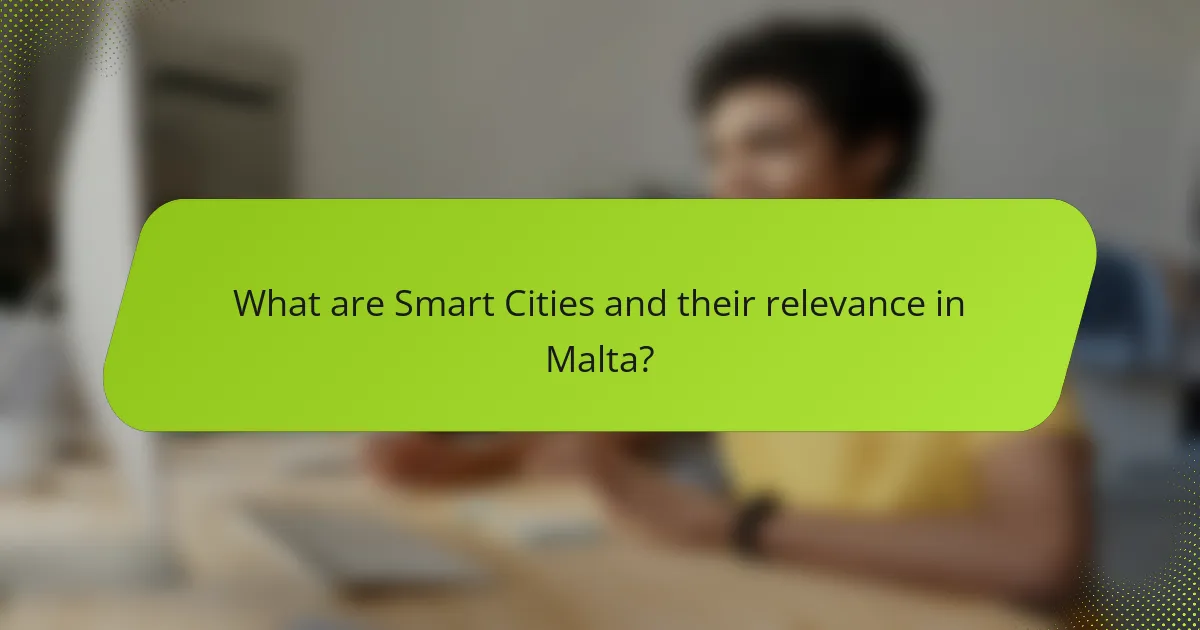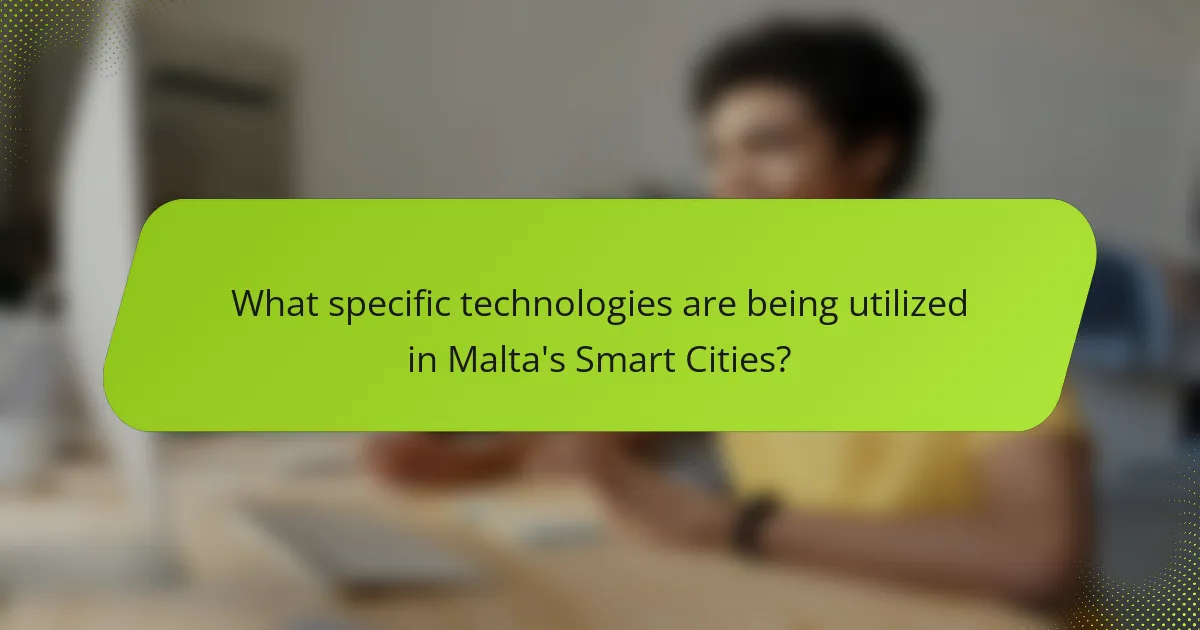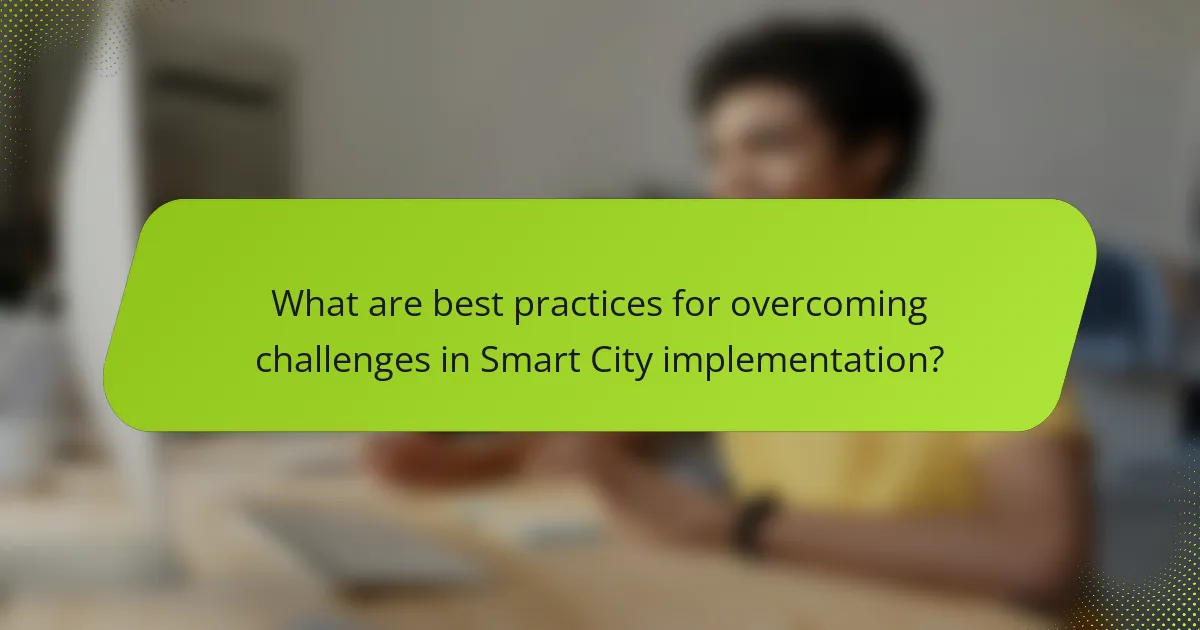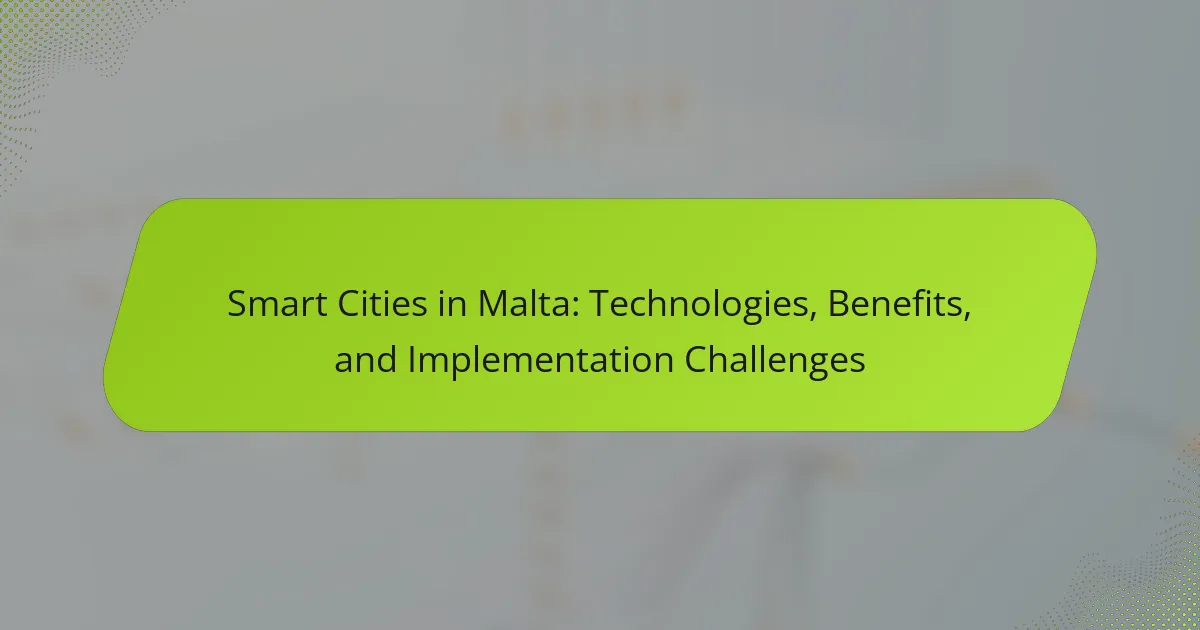
What are Smart Cities and their relevance in Malta?
Smart cities are urban areas that utilize digital technology to enhance performance and well-being. They integrate information and communication technology to manage assets and resources efficiently. In Malta, smart cities are relevant as they address urban challenges such as traffic congestion and waste management. The Maltese government has initiated projects to improve public services through technology. For example, the implementation of smart traffic systems aims to optimize flow and reduce delays. Additionally, smart waste management solutions are being adopted to enhance recycling efforts. These initiatives contribute to sustainability and improve the quality of life for residents. Malta’s commitment to becoming a smart nation reflects a broader trend in urban development worldwide.
How do Smart Cities integrate technology to improve urban living?
Smart Cities integrate technology to improve urban living by utilizing data-driven solutions. These cities implement smart infrastructure, such as sensors for traffic management. Real-time data collection enhances public transportation efficiency. Smart lighting systems reduce energy consumption and improve safety. Additionally, integrated waste management systems optimize collection routes. Citizens benefit from mobile applications that provide information on services. Smart grids support sustainable energy distribution and consumption. Research indicates that cities adopting these technologies experience increased quality of life and reduced operational costs.
What technologies are commonly used in Smart Cities?
Smart cities commonly use technologies such as IoT (Internet of Things), big data analytics, and cloud computing. IoT devices collect real-time data from various sources. This data is analyzed using big data analytics to improve urban services. Cloud computing provides the necessary infrastructure for data storage and processing. Additionally, smart transportation systems utilize GPS and mobile applications for efficient traffic management. Renewable energy technologies, such as solar panels, support sustainable energy solutions. Smart lighting systems enhance energy efficiency in public spaces. These technologies work together to create more efficient and livable urban environments.
How do these technologies enhance city services?
Technologies enhance city services by improving efficiency, accessibility, and responsiveness. Smart sensors monitor traffic and air quality in real-time. This data helps city planners make informed decisions. Mobile applications provide residents with instant access to services. They enable citizens to report issues directly to city officials. Data analytics optimize resource allocation, reducing waste. For example, smart waste management systems can schedule pickups based on fill levels. These advancements lead to better urban living conditions and increased citizen satisfaction.
What are the key benefits of implementing Smart City initiatives in Malta?
Implementing Smart City initiatives in Malta offers several key benefits. These initiatives enhance urban mobility through improved public transport systems. They promote energy efficiency by integrating smart grids and renewable energy sources. Smart technologies improve waste management, leading to cleaner urban environments. They also enhance public safety with advanced surveillance and emergency response systems. Economic growth is stimulated through the creation of tech jobs and innovation hubs. Additionally, Smart City initiatives foster community engagement by providing platforms for citizen participation. Improved data collection and analysis lead to better urban planning and resource allocation. Overall, these benefits contribute to a more sustainable and livable urban environment in Malta.
How do Smart Cities improve sustainability and environmental impact?
Smart Cities improve sustainability and environmental impact through advanced technologies and data-driven solutions. They utilize smart grids to optimize energy consumption and reduce waste. Smart transportation systems decrease traffic congestion and lower emissions. Green building technologies enhance energy efficiency in urban infrastructure. Waste management systems leverage IoT for efficient resource collection and recycling. According to the International Telecommunication Union, Smart Cities can reduce greenhouse gas emissions by up to 30%. These initiatives collectively lead to a more sustainable urban environment.
What economic advantages do Smart Cities provide to local communities?
Smart Cities provide significant economic advantages to local communities. They enhance efficiency in resource management, leading to cost savings. For example, smart energy systems can reduce energy consumption by up to 30%. Improved public transport systems can decrease travel times and increase productivity. Smart infrastructure attracts businesses, fostering job creation. According to a report by McKinsey, smart city initiatives could generate up to $1.5 trillion in economic value globally by 2025. Enhanced data analytics can lead to better decision-making, optimizing local budgets. Additionally, increased connectivity can boost local tourism and commerce. Overall, Smart Cities create a more sustainable and economically vibrant environment for communities.
What challenges does Malta face in the implementation of Smart Cities?
Malta faces several challenges in the implementation of Smart Cities. Limited financial resources hinder investment in advanced technologies. The small size of the country complicates infrastructure development and integration. Regulatory frameworks often lag behind technological advancements, creating bureaucratic obstacles. Data privacy concerns affect public trust in Smart City initiatives. Additionally, the need for skilled workforce strains existing educational resources. Public awareness and engagement are crucial, yet often lacking. These factors collectively impede the effective rollout of Smart City projects in Malta.
How do regulatory and policy issues affect Smart City projects?
Regulatory and policy issues significantly impact Smart City projects by shaping their frameworks and operational guidelines. These regulations dictate how technologies can be deployed and integrated into urban environments. For instance, compliance with data protection laws affects how cities manage citizen data collected through IoT devices. Policies on public safety influence the installation of surveillance systems and smart infrastructure. Moreover, funding and investment for Smart City initiatives often depend on government policies that prioritize sustainable development. A study by the European Commission highlights that clear regulatory frameworks enhance the success of Smart City projects by fostering innovation and collaboration. Ultimately, the alignment of local policies with Smart City objectives is crucial for effective implementation and community acceptance.
What technological barriers hinder Smart City development in Malta?
Limited digital infrastructure hinders Smart City development in Malta. The country’s internet connectivity lacks the speed and reliability needed for advanced smart technologies. High costs of implementing smart infrastructure also pose a challenge. Budget constraints limit investments in necessary technologies. Additionally, data privacy regulations create barriers to data sharing and integration. The lack of skilled workforce in emerging technologies further complicates development efforts. Limited collaboration between public and private sectors slows down innovation. These factors collectively impede the progress of Smart City initiatives in Malta.
What role do citizens play in the development of Smart Cities in Malta?
Citizens play a crucial role in the development of Smart Cities in Malta. Their participation influences decision-making processes. Citizens provide feedback on urban planning and services. Public consultations allow residents to voice their needs and preferences. This input helps shape technology integration in city services. For example, citizen engagement can improve public transport systems. Active participation fosters a sense of community ownership. It also encourages collaboration between local authorities and residents. This collaborative approach enhances the effectiveness of smart city initiatives.
How can public engagement enhance Smart City initiatives?
Public engagement can enhance Smart City initiatives by fostering collaboration between citizens and local governments. Engaged citizens provide valuable insights into community needs and preferences. This involvement can lead to more effective and tailored solutions. For example, public feedback can improve urban planning and service delivery. Studies show that cities with high public participation experience greater satisfaction and trust in local governance. Engaging the public also encourages transparency and accountability in decision-making processes. Furthermore, it can lead to increased investment and support for Smart City projects. Engaged communities are more likely to adopt and utilize new technologies effectively. Overall, public engagement is crucial for the success and sustainability of Smart City initiatives.
What feedback mechanisms are effective for citizen participation?
Effective feedback mechanisms for citizen participation include surveys, public forums, and digital platforms. Surveys gather quantitative data and opinions from citizens. Public forums allow for face-to-face dialogue and community engagement. Digital platforms, such as mobile apps and websites, facilitate ongoing communication and feedback collection.
Research indicates that these mechanisms enhance transparency and accountability in governance. For instance, a study by the European Commission found that digital tools improve citizen engagement by 30%. This demonstrates the effectiveness of these feedback mechanisms in fostering active participation.

What specific technologies are being utilized in Malta’s Smart Cities?
Malta’s Smart Cities utilize various specific technologies. These include Internet of Things (IoT) devices for real-time data collection. Smart traffic management systems enhance urban mobility and reduce congestion. Renewable energy solutions, such as solar panels, are integrated into infrastructure. Advanced waste management systems optimize collection routes and reduce costs. Smart lighting systems improve energy efficiency and public safety. Data analytics platforms process information for better urban planning. Mobile applications enhance citizen engagement and service accessibility. These technologies collectively improve the quality of life in urban areas.
How is data analytics used to enhance urban planning in Smart Cities?
Data analytics enhances urban planning in Smart Cities by providing actionable insights from large datasets. It allows city planners to analyze traffic patterns, optimize public transportation routes, and improve infrastructure development. For example, real-time data can reveal peak traffic times, enabling adjustments to traffic signals for smoother flow. Analytics also supports environmental monitoring, helping to assess air quality and implement sustainable practices. Furthermore, citizen engagement is enhanced through data-driven feedback mechanisms, allowing residents to participate in decision-making. Studies show that cities using data analytics report improved resource allocation and reduced operational costs. In Malta, initiatives are underway to integrate data analytics into urban planning to foster smarter, more efficient city management.
What are the sources of data for urban analytics?
Sources of data for urban analytics include various types of information collected from different channels. Key sources are government databases, which provide demographic and infrastructure data. Sensor networks contribute real-time data on traffic and environmental conditions. Social media platforms offer insights into public sentiment and behavior patterns. Geographic information systems (GIS) supply spatial data for mapping urban features. Surveys and citizen engagement initiatives gather qualitative data directly from residents. Academic research contributes empirical studies relevant to urban trends. These sources collectively inform urban planning and policy-making.
How does data-driven decision making improve city management?
Data-driven decision making improves city management by enabling informed choices based on empirical evidence. It allows city officials to analyze data trends and patterns effectively. This leads to optimized resource allocation and enhanced service delivery. For instance, cities can use real-time traffic data to manage congestion. Additionally, data analytics can identify areas needing infrastructure upgrades. A study by McKinsey found that cities using data analytics improved operational efficiency by 20-30%. This demonstrates the tangible benefits of adopting data-driven strategies in urban governance.
What smart transportation solutions are being implemented in Malta?
Malta is implementing various smart transportation solutions to enhance mobility. These include the development of an integrated transport management system. This system utilizes real-time data to optimize traffic flow and reduce congestion. Additionally, Malta is investing in electric vehicle (EV) infrastructure. Charging stations for EVs are being installed across the islands. Public transport is also being modernized with the introduction of smart ticketing systems. These systems allow for contactless payments and improved user experience. Furthermore, bike-sharing programs are being expanded to promote sustainable transport options. These initiatives aim to create a more efficient and eco-friendly transport network in Malta.
How do smart traffic management systems work?
Smart traffic management systems utilize advanced technologies to optimize traffic flow. They employ sensors, cameras, and data analytics to monitor real-time traffic conditions. These systems adjust traffic signals based on current traffic volume and patterns. For instance, they can reduce wait times at intersections by changing signal timings. Additionally, they provide information to drivers through variable message signs. This information can include traffic conditions, travel times, and alternate routes. Studies show that smart traffic systems can reduce congestion by up to 30%. They enhance road safety by minimizing accidents through better traffic control.
What benefits do electric and autonomous vehicles bring to Smart Cities?
Electric and autonomous vehicles enhance Smart Cities by improving air quality and reducing traffic congestion. These vehicles produce zero emissions, which leads to cleaner urban environments. In addition, they optimize traffic flow through advanced algorithms, minimizing delays. Studies show that electric vehicles contribute to a significant reduction in greenhouse gas emissions. Autonomous vehicles can communicate with each other, further enhancing road safety. Research indicates that these technologies can decrease accident rates by up to 90%. Moreover, electric and autonomous vehicles promote energy efficiency, integrating with renewable energy sources. This synergy supports the overall sustainability goals of Smart Cities.

What are best practices for overcoming challenges in Smart City implementation?
Best practices for overcoming challenges in Smart City implementation include stakeholder engagement, robust planning, and iterative development. Engaging stakeholders ensures that community needs are addressed. This involvement fosters trust and collaboration among residents, businesses, and government entities. Robust planning involves setting clear objectives and timelines. A structured approach helps in identifying potential obstacles early. Iterative development allows for flexibility and adaptation. This method enables cities to refine solutions based on feedback and changing circumstances. Additionally, investing in technology infrastructure is crucial. A strong technological foundation supports data integration and system interoperability. Finally, continuous education and training for city officials and staff enhance capacity. These practices collectively contribute to successful Smart City initiatives.
How can collaboration between stakeholders facilitate Smart City success?
Collaboration between stakeholders can facilitate Smart City success by ensuring aligned goals and resource sharing. Stakeholders include government, private sector, and community organizations. Effective communication among these groups enhances project planning and implementation. Joint efforts lead to innovative solutions tailored to local needs. Sharing data and technology fosters transparency and trust. Research shows that cities with collaborative frameworks see improved service delivery. For instance, the European Commission emphasizes the role of partnerships in achieving sustainable urban development. This collaborative approach ultimately drives efficiency and effectiveness in Smart City initiatives.
What partnerships are essential for effective Smart City projects?
Essential partnerships for effective Smart City projects include collaboration with local governments, technology providers, and community organizations. Local governments provide regulatory support and funding. Technology providers offer innovative solutions for data management and infrastructure. Community organizations engage residents and ensure the projects meet local needs. Academic institutions contribute research and expertise. Private sector partnerships can drive investment and foster innovation. These collaborations enhance resource sharing and knowledge exchange. Successful examples include cities like Barcelona and Singapore, where partnerships led to improved urban services and sustainability.
How can knowledge sharing improve project outcomes?
Knowledge sharing can significantly improve project outcomes by enhancing collaboration and innovation. When team members share their expertise, it leads to better problem-solving. This exchange of information helps identify potential risks early in the project lifecycle. Research shows that projects with effective knowledge sharing are 25% more likely to meet their objectives. Furthermore, shared knowledge fosters a culture of continuous learning. This results in increased efficiency and reduced duplication of efforts. Ultimately, knowledge sharing creates a more agile project environment. Agile environments adapt quickly to changes, leading to successful project delivery.
What strategies can be adopted to ensure sustainable Smart City growth?
Adopting integrated planning and management strategies is essential for sustainable Smart City growth. These strategies include stakeholder engagement to ensure community needs are met. Implementing smart technologies can optimize resource use and reduce waste. Data-driven decision-making enhances urban planning efficiency. Sustainable transportation options, such as electric public transport, reduce carbon footprints. Energy-efficient infrastructure minimizes energy consumption. Green spaces improve urban biodiversity and quality of life. Collaboration with private sectors can foster innovation and investment in sustainable projects.
How do funding models impact the sustainability of Smart City initiatives?
Funding models significantly impact the sustainability of Smart City initiatives. Sustainable funding ensures ongoing investment in technology and infrastructure. Public-private partnerships often provide essential resources and expertise. Diverse funding sources, including governmental grants and private investments, enhance financial stability. Inadequate funding can lead to project delays and reduced effectiveness. For example, cities with stable funding have successfully implemented smart traffic systems. Conversely, those with limited funding struggle to maintain existing technologies. Sustainable funding models support continuous innovation and adaptation to changing needs.
What role does public-private partnership play in Smart City funding?
Public-private partnerships (PPPs) are crucial for Smart City funding. They leverage resources and expertise from both sectors. This collaboration enhances project viability and financial sustainability. PPPs can facilitate investments in infrastructure, technology, and services. They also help distribute risks between public and private entities. For instance, a study by the World Bank highlights successful PPPs in urban development. This model often accelerates project timelines and improves service delivery. Overall, PPPs play a vital role in financing and implementing Smart City initiatives effectively.
What practical tips can cities follow to successfully implement Smart City technologies?
Cities can successfully implement Smart City technologies by following several practical tips. First, they should engage stakeholders early in the planning process. This includes residents, businesses, and local organizations. Second, cities must conduct a thorough needs assessment. Identifying specific community needs helps tailor technology solutions effectively. Third, establishing a clear governance structure is essential. This ensures accountability and streamlined decision-making. Fourth, cities should invest in scalable infrastructure. Flexible systems can adapt to future technological advancements. Fifth, fostering partnerships with technology providers can enhance innovation. Collaborating with experts ensures access to the latest solutions. Sixth, cities must prioritize data privacy and security. Implementing robust protocols builds public trust and encourages participation. Lastly, continuous evaluation and feedback mechanisms should be established. Regular assessments help improve and optimize Smart City initiatives over time.
Smart Cities in Malta refer to urban areas that leverage digital technology to enhance performance and improve residents’ quality of life. The article explores the integration of technologies such as IoT, data analytics, and smart infrastructure to address urban challenges like traffic congestion and waste management. Key benefits of these initiatives include enhanced urban mobility, energy efficiency, and economic growth, while challenges such as limited financial resources and regulatory hurdles are also discussed. The role of citizen engagement and public-private partnerships in the successful implementation of Smart City projects is emphasized, along with practical strategies for sustainable growth.
